Abstract
OBJECTIVES--To assess further the relation in Intersalt of 24 hour urinary sodium to blood pressure of individuals and populations, and the difference in blood pressure from young adulthood into middle age. DESIGN--Standardised cross sectional study within and across populations. SETTING--52 population samples in 32 countries. SUBJECTS--10,074 men and women aged 20-59. MAIN OUTCOME MEASURES--Association of sodium and blood pressure from within population and cross population multiple linear regression analyses with multivariate correction for regression dilution bias. Relation of sample median daily urinary sodium excretion to difference in blood pressure with age. RESULTS--In within population analyses (n = 10,074), individual 24 hour urinary sodium excretion higher by 100 mmol (for example, 170 v 70 mmol) was associated with systolic/diastolic blood pressure higher on average by 3/0 to 6/3 mm Hg (with and without body mass in analyses). Associations were larger at ages 40-59. In cross population analyses (n = 52), sample median 24 hour sodium excretion higher by 100 mmol was associated with median systolic/diastolic pressure higher on average by 5-7/2-4 mm Hg, and estimated mean difference in systolic/diastolic pressure at age 55 compared with age 25 greater by 10-11/6 mm Hg. CONCLUSIONS--The strong, positive association of urinary sodium with systolic pressure of individuals concurs with Intersalt cross population findings and results of other studies. Higher urinary sodium is also associated with substantially greater differences in blood pressure in middle age compared with young adulthood. These results support recommendations for reduction of high salt intake in populations for prevention and control of adverse blood pressure levels.
Full text
PDF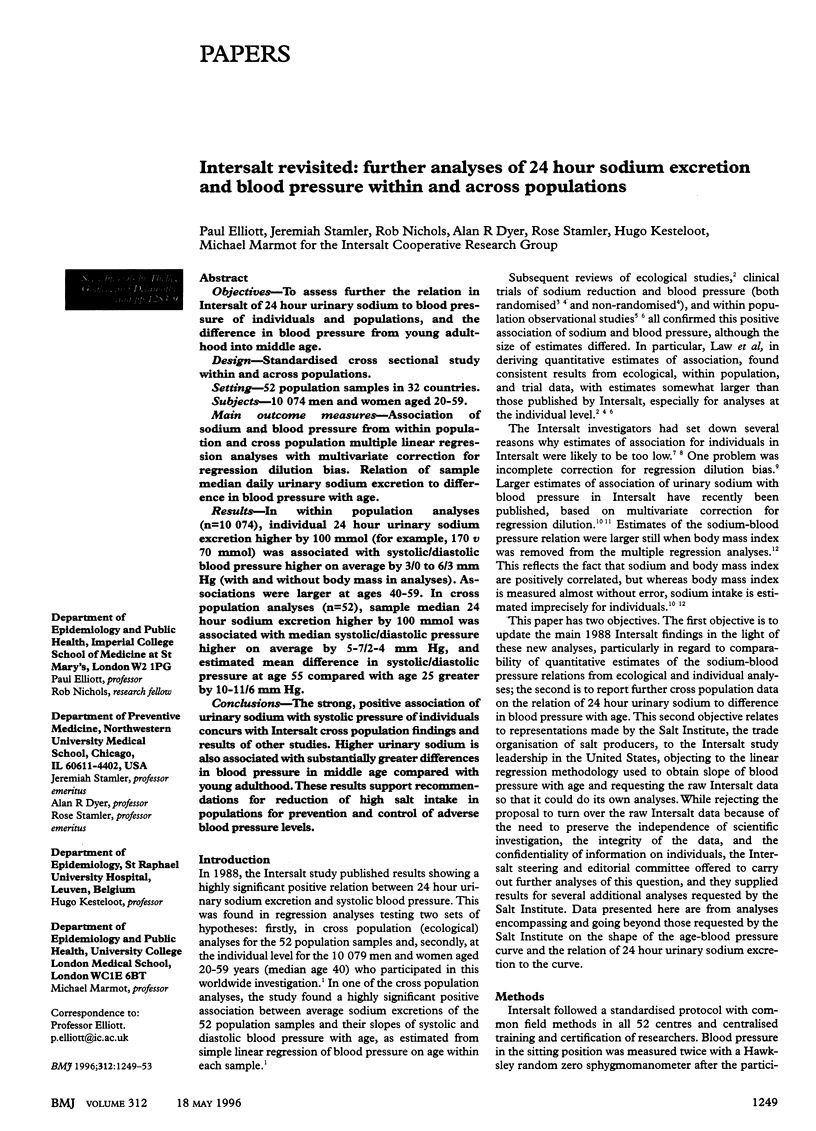
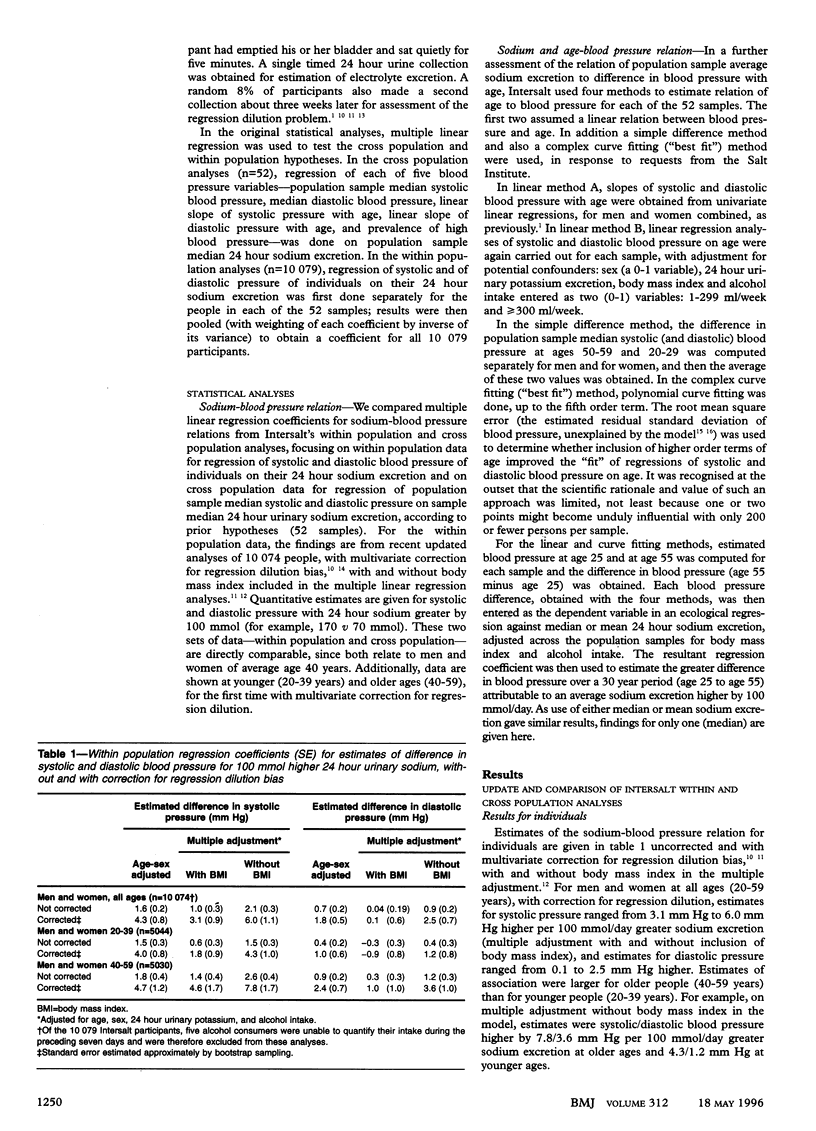
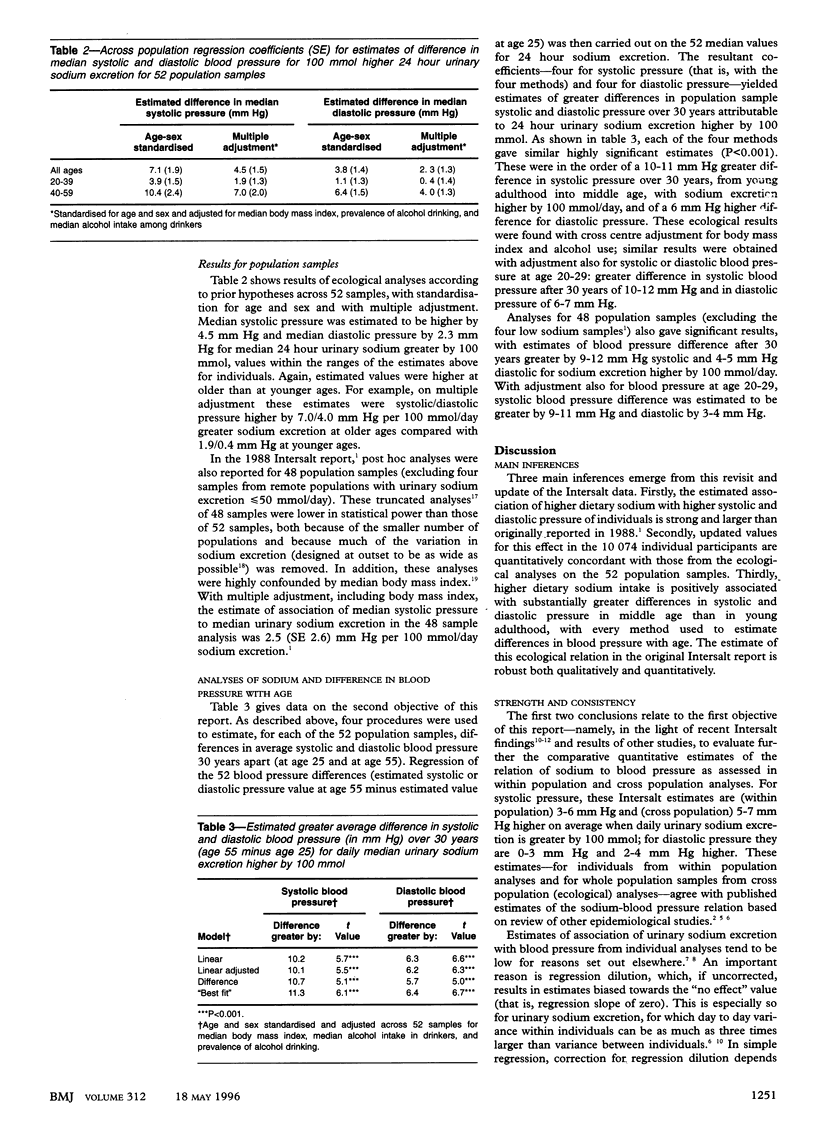
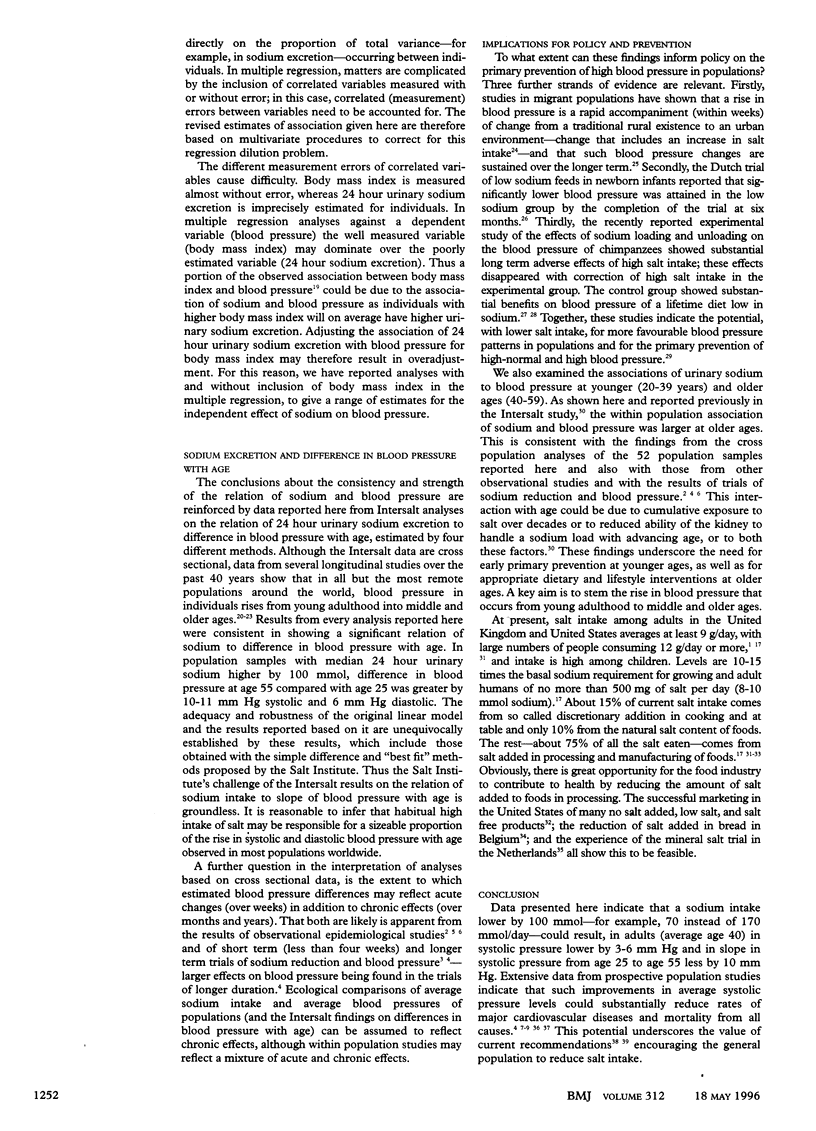
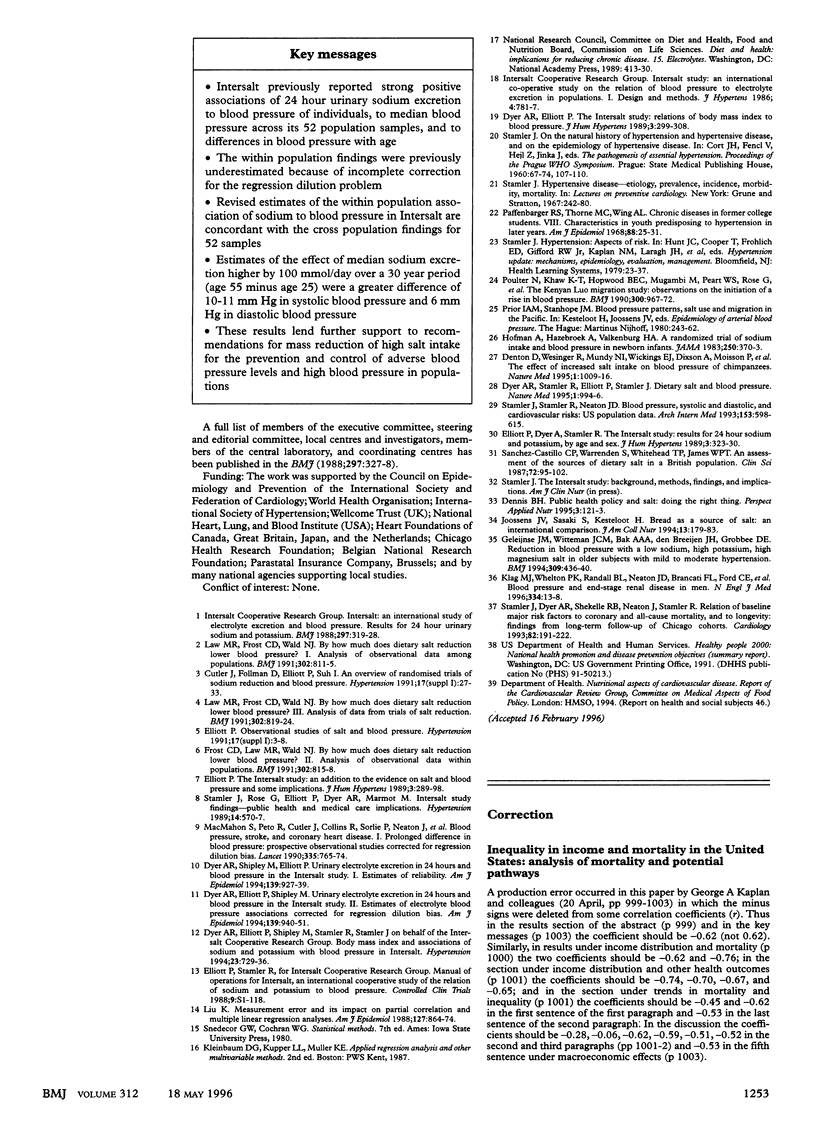
Selected References
These references are in PubMed. This may not be the complete list of references from this article.
- Denton D., Weisinger R., Mundy N. I., Wickings E. J., Dixson A., Moisson P., Pingard A. M., Shade R., Carey D., Ardaillou R. The effect of increased salt intake on blood pressure of chimpanzees. Nat Med. 1995 Oct;1(10):1009–1016. doi: 10.1038/nm1095-1009. [DOI] [PubMed] [Google Scholar]
- Dyer A. R., Elliott P., Shipley M. Urinary electrolyte excretion in 24 hours and blood pressure in the INTERSALT Study. II. Estimates of electrolyte-blood pressure associations corrected for regression dilution bias. The INTERSALT Cooperative Research Group. Am J Epidemiol. 1994 May 1;139(9):940–951. doi: 10.1093/oxfordjournals.aje.a117100. [DOI] [PubMed] [Google Scholar]
- Dyer A. R., Elliott P. The INTERSALT study: relations of body mass index to blood pressure. INTERSALT Co-operative Research Group. J Hum Hypertens. 1989 Oct;3(5):299–308. [PubMed] [Google Scholar]
- Dyer A. R., Shipley M., Elliott P. Urinary electrolyte excretion in 24 hours and blood pressure in the INTERSALT Study. I. Estimates of reliability. The INTERSALT Cooperative Research Group. Am J Epidemiol. 1994 May 1;139(9):927–939. doi: 10.1093/oxfordjournals.aje.a117099. [DOI] [PubMed] [Google Scholar]
- Dyer A. R., Stamler R., Elliott P., Stamler J. Dietary salt and blood pressure. Nat Med. 1995 Oct;1(10):994–996. doi: 10.1038/nm1095-994. [DOI] [PubMed] [Google Scholar]
- Elliott P., Dyer A., Stamler R. The INTERSALT study: results for 24 hour sodium and potassium, by age and sex. INTERSALT Co-operative Research Group. J Hum Hypertens. 1989 Oct;3(5):323–330. [PubMed] [Google Scholar]
- Elliott P. The INTERSALT study: an addition to the evidence on salt and blood pressure, and some implications. J Hum Hypertens. 1989 Oct;3(5):289–298. [PubMed] [Google Scholar]
- Frost C. D., Law M. R., Wald N. J. By how much does dietary salt reduction lower blood pressure? II--Analysis of observational data within populations. BMJ. 1991 Apr 6;302(6780):815–818. doi: 10.1136/bmj.302.6780.815. [DOI] [PMC free article] [PubMed] [Google Scholar]
- Geleijnse J. M., Witteman J. C., Bak A. A., den Breeijen J. H., Grobbee D. E. Reduction in blood pressure with a low sodium, high potassium, high magnesium salt in older subjects with mild to moderate hypertension. BMJ. 1994 Aug 13;309(6952):436–440. doi: 10.1136/bmj.309.6952.436. [DOI] [PMC free article] [PubMed] [Google Scholar]
- Hofman A., Hazebroek A., Valkenburg H. A. A randomized trial of sodium intake and blood pressure in newborn infants. JAMA. 1983 Jul 15;250(3):370–373. [PubMed] [Google Scholar]
- Joossens J. V., Sasaki S., Kesteloot H. Bread as a source of salt: an international comparison. J Am Coll Nutr. 1994 Apr;13(2):179–183. doi: 10.1080/07315724.1994.10718392. [DOI] [PubMed] [Google Scholar]
- Law M. R., Frost C. D., Wald N. J. By how much does dietary salt reduction lower blood pressure? I--Analysis of observational data among populations. BMJ. 1991 Apr 6;302(6780):811–815. doi: 10.1136/bmj.302.6780.811. [DOI] [PMC free article] [PubMed] [Google Scholar]
- Law M. R., Frost C. D., Wald N. J. By how much does dietary salt reduction lower blood pressure? III--Analysis of data from trials of salt reduction. BMJ. 1991 Apr 6;302(6780):819–824. doi: 10.1136/bmj.302.6780.819. [DOI] [PMC free article] [PubMed] [Google Scholar]
- MacMahon S., Peto R., Cutler J., Collins R., Sorlie P., Neaton J., Abbott R., Godwin J., Dyer A., Stamler J. Blood pressure, stroke, and coronary heart disease. Part 1, Prolonged differences in blood pressure: prospective observational studies corrected for the regression dilution bias. Lancet. 1990 Mar 31;335(8692):765–774. doi: 10.1016/0140-6736(90)90878-9. [DOI] [PubMed] [Google Scholar]
- Poulter N. R., Khaw K. T., Hopwood B. E., Mugambi M., Peart W. S., Rose G., Sever P. S. The Kenyan Luo migration study: observations on the initiation of a rise in blood pressure. BMJ. 1990 Apr 14;300(6730):967–972. doi: 10.1136/bmj.300.6730.967. [DOI] [PMC free article] [PubMed] [Google Scholar]
- Sanchez-Castillo C. P., Warrender S., Whitehead T. P., James W. P. An assessment of the sources of dietary salt in a British population. Clin Sci (Lond) 1987 Jan;72(1):95–102. doi: 10.1042/cs0720095. [DOI] [PubMed] [Google Scholar]
- Stamler J., Dyer A. R., Shekelle R. B., Neaton J., Stamler R. Relationship of baseline major risk factors to coronary and all-cause mortality, and to longevity: findings from long-term follow-up of Chicago cohorts. Cardiology. 1993;82(2-3):191–222. doi: 10.1159/000175868. [DOI] [PubMed] [Google Scholar]
- Stamler J., Rose G., Stamler R., Elliott P., Dyer A., Marmot M. INTERSALT study findings. Public health and medical care implications. Hypertension. 1989 Nov;14(5):570–577. doi: 10.1161/01.hyp.14.5.570. [DOI] [PubMed] [Google Scholar]
- Stamler J., Stamler R., Neaton J. D. Blood pressure, systolic and diastolic, and cardiovascular risks. US population data. Arch Intern Med. 1993 Mar 8;153(5):598–615. doi: 10.1001/archinte.153.5.598. [DOI] [PubMed] [Google Scholar]


